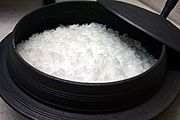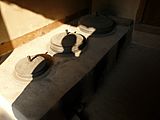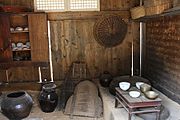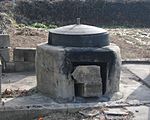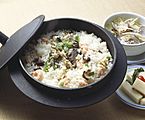Gamasot facts for kids
| Gamasot | |
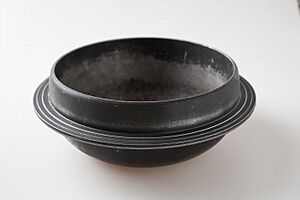 |
|
Quick facts for kids Korean name |
|
|---|---|
| Hangul |
가마솥
|
| Revised Romanization | gamasot |
| McCune–Reischauer | kamasot |
| IPA | [ka.ma.sot̚] |
| Alternative name | |
| Hangul |
솥
|
| Revised Romanization | sot |
| McCune–Reischauer | sot |
| IPA | [sot̚] |
A Gamasot (pronounced gah-mah-sot), or just sot, is a super big and heavy cooking pot. It's like a giant cauldron that has been a key part of Korean cooking for a very long time! These special pots are known for their large size and strong build. They are perfect for making huge batches of food for families or communities.
Contents
The History of Gamasot Pots
The idea for the sot pot started with something called a "Chung," which was made from bronze. Experts think that bronze was easier to work with than steel back then. Bronze sot pots are often found from the Three Kingdoms period (around 57 BCE – 668 CE). During this time, the "Chung" was a symbol of the nation, the king's power, and even industry.
But iron sot pots have an even older history! They go all the way back to the Bronze Age, which was much earlier than the Three Kingdoms period. The first copper sot pots found in Korea were from the Gojoseon period. This was a very old kingdom that existed during the late Bronze Age. Many sot pots have been found in places like 'Hansa-gun', which was set up after Gojoseon was taken over in 108 BC. The 'Nakrang-gun' area is especially famous for having the most pots found among these ancient sites.
What a Gamasot Looks Like
Gamasot pots are very large and deep. This design was perfect for the big families common in Korea. The word gama usually refers to the stove or fire pit where the pot sits. The word sot means the pot or bowl itself, especially one used for cooking rice.
A gamasot doesn't have legs. Its bottom is round, and it usually has a small dip around the top edge. There are often four bumps or handles on the sides. These make it easy to place the pot securely over a stove. The lid is also made of iron and has a convenient handle in the middle.
Gamasot's Important Role
For a long time, the sot pot was more than just a cooking tool. It was a symbol of power, the state, and even a king's rule. People used these pots to record important achievements or for special ceremonies. They were also used to prepare food for religious events or for honoring ancestors.
Cooking rice in a gamasot has been a tradition in Korea for a very long time. This custom started at least during the time of King Daemusin (18–44 CE) in the ancient kingdom of Goguryeo.
How Gamasot Pots Are Used
In a traditional hanok (Korean house) kitchen, the agungi is a special fireplace used for both heating the house and cooking. The gamasot is a large pot made to fit right into this agungi. Because gamasots are so big, they are usually kept in place on the agungi almost all the time.
The gamasot is a traditional Korean pot that has been a central part of kitchens for centuries. It was used for almost everything! From boiling water and cooking rice to frying side dishes and steaming food. The gamasot was a very important cooking tool that Korean families relied on daily. It truly represents the history and heart of a Korean family's kitchen.
Gallery
-
Sotbap, which is rice cooked in a gamasot.
-
A gamasot displayed at the Korean War Memorial.




